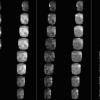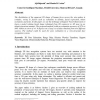106 search results - page 10 / 22 » Feature Modelling of PCA Difference Vectors for 2D and 3D Fa... |
ICCV
2007
IEEE
14 years 10 months ago
2007
IEEE
Reliable 3D tracking is still a difficult task. Most parametrized 3D deformable models rely on the accurate extraction of image features for updating their parameters, and are pro...
ICPR
2004
IEEE
14 years 9 months ago
2004
IEEE
The performance of face recognition systems that use twodimensional (2D) images is dependent on consistent conditions such as lighting, pose and facial expression. We are developi...
CVPR
2005
IEEE
14 years 10 months ago
2005
IEEE
Researchers have been working on human face recognition for decades. Face recognition is hard due to different types of variations in face images, such as pose, illumination and e...
PRL
2007
13 years 8 months ago
2007
Two-dimensional principal component analysis (2DPCA) is based on the 2D images rather than 1D vectorized images like PCA, which is a classical feature extraction technique in face...
IVC
2006
13 years 8 months ago
2006
The distribution of the apparent 3D shape of human faces across the view-sphere is complex, owing to factors such as variations in identity, facial expression, minor occlusions an...


